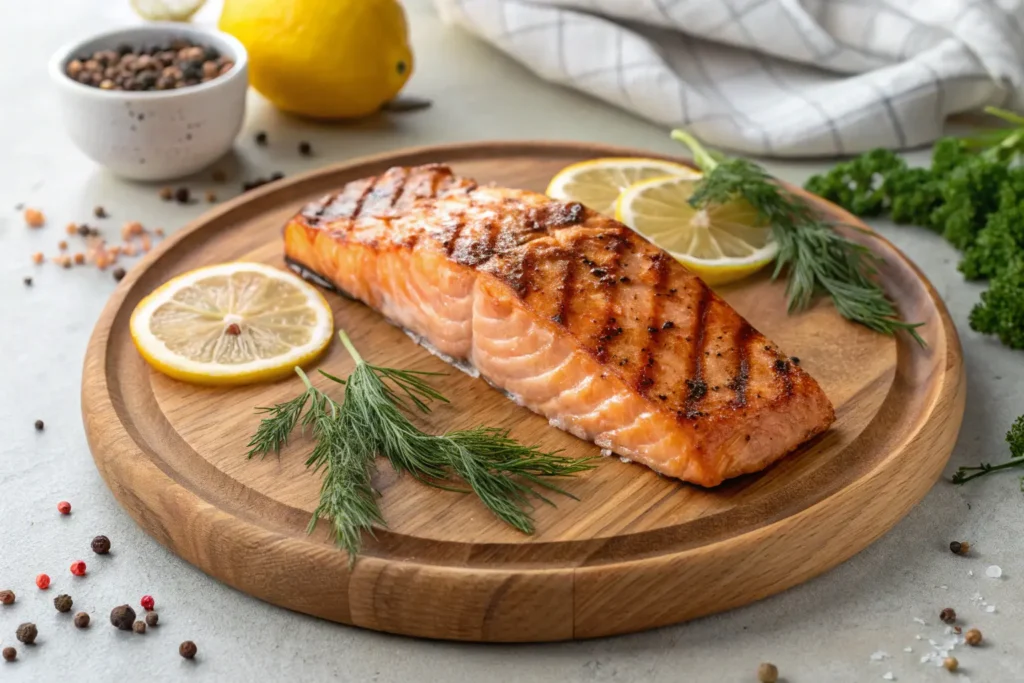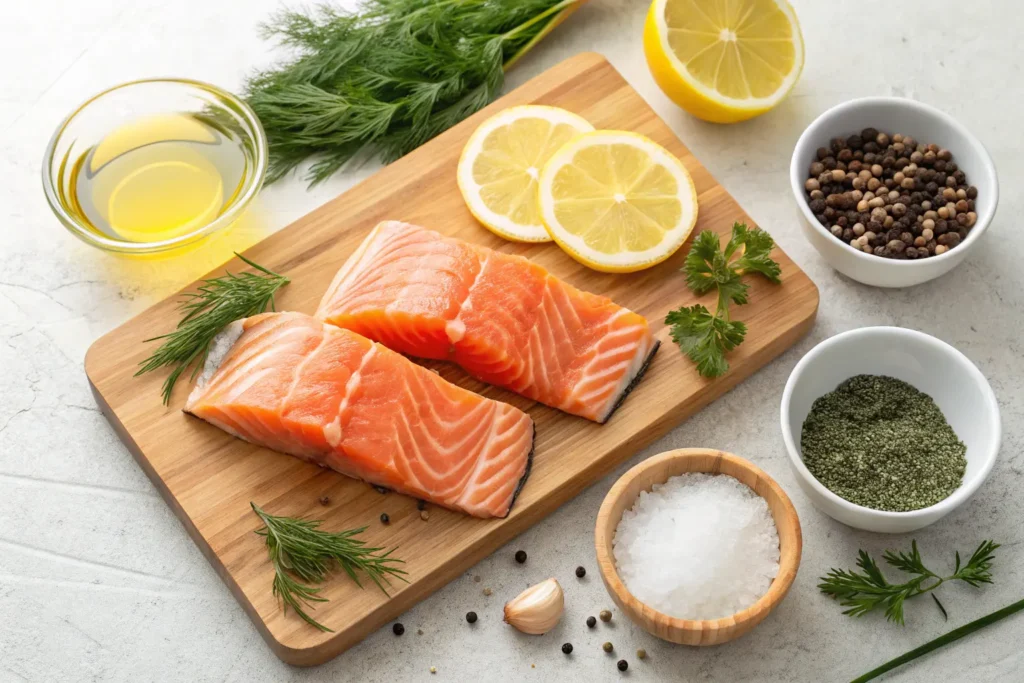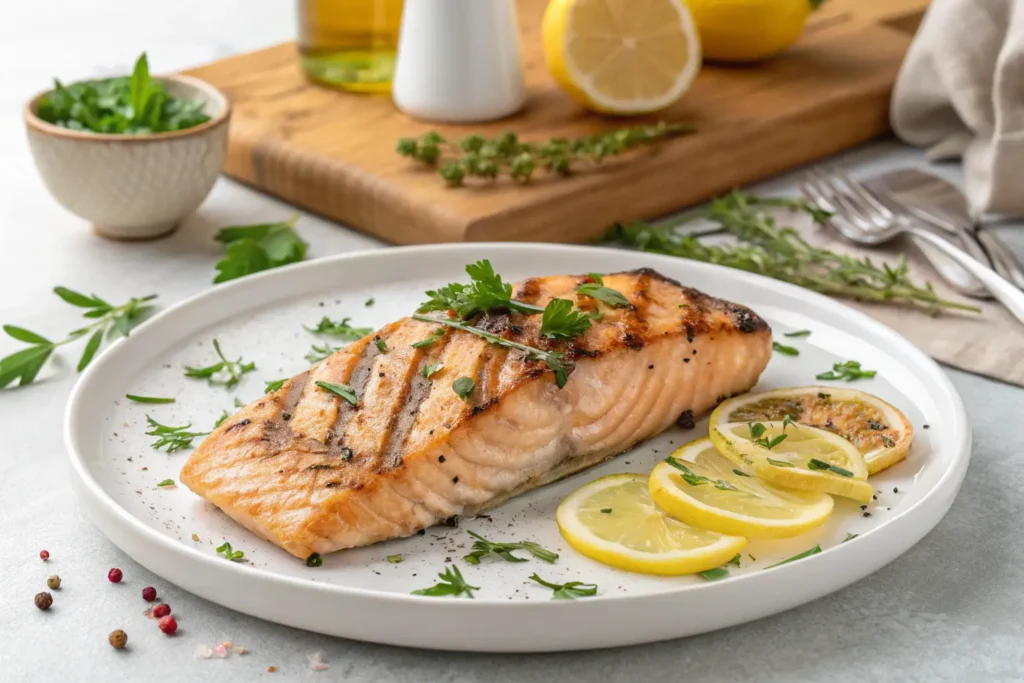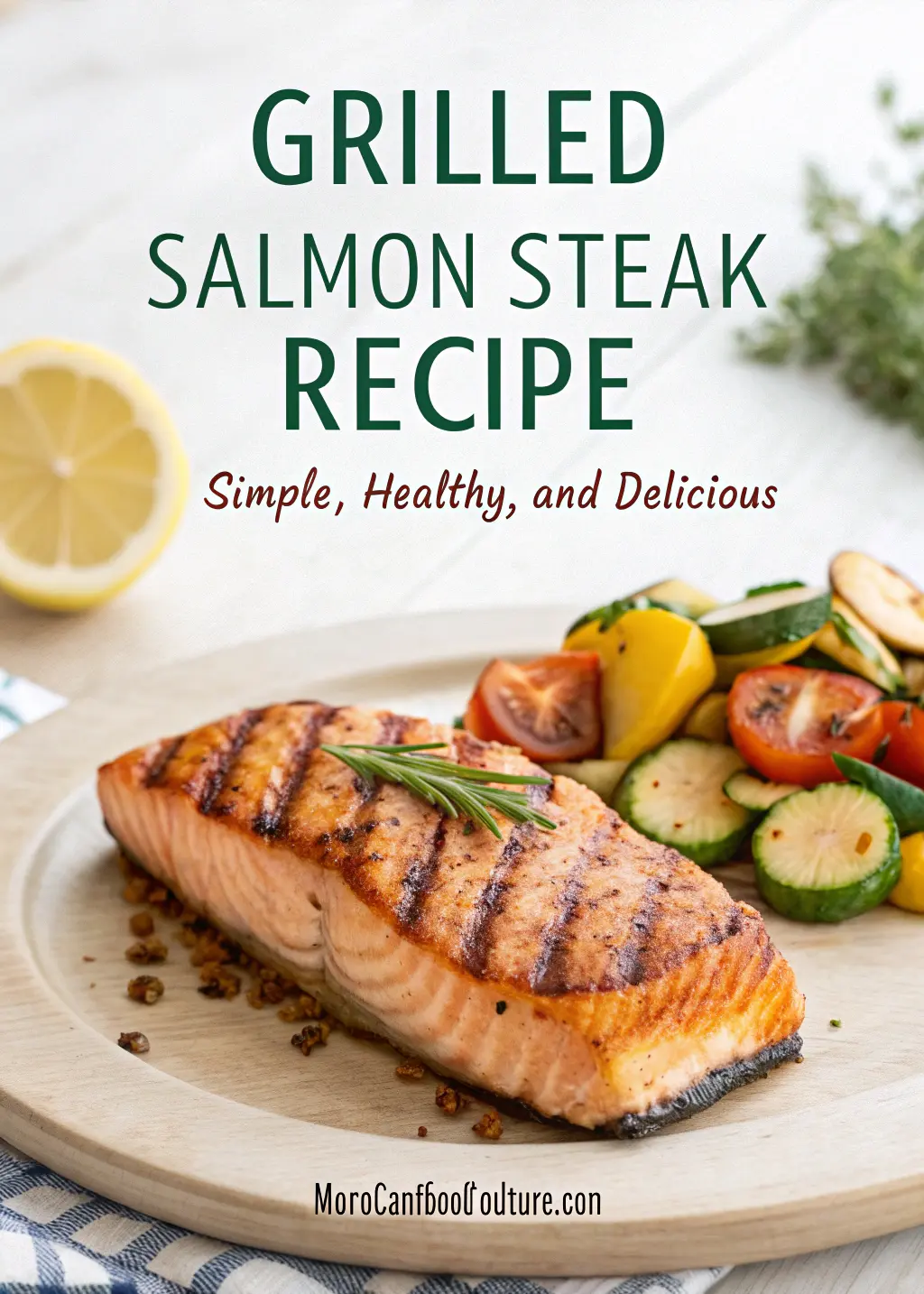Remember that evening when unexpected dinner guests announced their arrival, and panic seized your thoughts? For me, that moment transformed into a revelation when I discovered the remarkable versatility of salmon steaks. The sizzle hitting the grill, that distinctive aroma wafting through the summer air, and the collective hush falling over the table with the first bite—these moments reshape our relationship with home cooking.
Many home chefs hesitate before attempting fish on the grill, fearing the dreaded stick-and-shred disaster that leaves dinner plans in ruins. Yet, salmon steaks offer forgiveness that most seafood varieties simply don’t. Let’s demystify the process and transform your next dinner into something extraordinary with minimal effort and maximum flavor.
Table of Contents

Why Salmon Steaks Should Be Your Go-To Healthy Protein
When navigating the sea of protein options, salmon steaks stand apart through a remarkable nutritional profile combined with culinary versatility. Unlike chicken breasts that often require extensive preparation to avoid dryness, or red meats with their associated health concerns, salmon delivers exceptional nutrition while maintaining incredible flavor.
These cross-cut wonders differ significantly from their more commonly known counterparts, salmon fillets. While fillets represent a lengthwise cut along the backbone, salmon steaks feature a cross-section cut through the fish, backbone intact. This structural difference creates a sturdier piece that holds together beautifully during grilling, making them considerably more forgiving for novice grill masters.
The distinctive bone structure running through the center provides natural insulation during cooking, helping preserve moisture and preventing the dreaded overcooking that plagues many seafood preparations.
Nutrition Breakdown of Salmon Steaks
Before exploring preparation techniques, understanding what makes salmon a nutritional powerhouse helps appreciate why it deserves regular rotation in your meal planning:
| Nutrient | Amount (per 6oz serving) | Benefit |
|---|---|---|
| Protein | 34 grams | Muscle maintenance and growth |
| Omega-3 Fatty Acids | 1.8 grams | Brain health, reduced inflammation |
| Vitamin D | 112% DV | Bone health, immune function |
| Vitamin B12 | 106% DV | Energy production, nerve function |
| Selenium | 85% DV | Antioxidant protection |
This impressive nutritional profile explains why healthcare professionals consistently recommend including fatty fish like salmon in your diet at least twice weekly. The combination of lean protein and heart-healthy fats creates a satisfying meal that supports wellness without sacrificing flavor.
Essential Ingredients for Perfect Grilled Salmon Steaks
Selecting the Best Salmon Steaks
Your culinary journey begins at the market, where selecting quality salmon steaks sets the foundation for an exceptional meal. Look for cuts displaying vibrant, deep coral-pink flesh—pale or browning edges indicate age and potential quality issues. Thickness matters significantly; aim for steaks measuring approximately one inch thick, which allows proper cooking without drying.
When choosing between varieties, consider these excellent options:
- Sockeye salmon offers deep red flesh with pronounced flavor, perfect for those who appreciate distinctive seafood character
- King salmon provides larger, fattier steaks with buttery texture, ideal for special occasions
- Coho salmon balances mild flavor with moderate fat content, making it wonderfully versatile
The wild versus farm-raised debate deserves consideration based on your priorities. Wild-caught salmon typically delivers more intense flavor and higher omega-3 content, though carefully managed farm-raised options increasingly provide sustainable alternatives with consistent quality and lower environmental contaminants.
The Complete Ingredients List
| Ingredient | Quantity | Notes |
|---|---|---|
| Salmon steaks | 4 (6-8 oz each) | About 1-inch thick, skin-on preferred |
| Olive oil | 2 tablespoons | Cold-pressed extra virgin recommended |
| Lemon | 1 large | Utilize zest and juice separately |
| Garlic | 3 cloves | Smashed then minced for maximum flavor |
| Fresh dill | 2 tablespoons | Finely chopped (substitute 2 tsp dried if necessary) |
| Kosher salt | 1 teaspoon | Flaky sea salt reserved for finishing |
| Black pepper | ½ teaspoon | Freshly cracked provides superior flavor |
| Dijon mustard | 1 tablespoon | Adds emulsification and subtle tang |
| Honey | 1 teaspoon | Balances acidity and promotes caramelization |
Simple Marinade Magic for Flavorful Salmon Steaks
The Quick 15-Minute Marinade
Contrary to common practice with meats, fish benefits from brief marinade exposure. Extended acidic baths begin breaking down delicate proteins, potentially creating mushy texture. The 15-minute approach provides flavor penetration while maintaining structural integrity.
Follow these straightforward steps:
- Combine olive oil, freshly squeezed lemon juice, minced garlic, and chopped dill in a medium bowl
- Whisk in Dijon mustard and honey until fully incorporated, creating a smooth emulsion
- Season the mixture with kosher salt and freshly ground pepper
- Place salmon steaks in a shallow glass or ceramic dish, then pour marinade evenly over them
- Allow flavors to meld for precisely 15 minutes—set a timer to prevent over-marinating
This brief interval provides sufficient time for flavor molecules to begin surface penetration without triggering protein breakdown. The oil-based components create a protective barrier that prevents moisture loss during cooking while transferring fat-soluble flavors to the fish.

Alternative Marinades for Salmon Steaks
While the classic preparation delivers consistently excellent results, experimenting with flavor profiles keeps your culinary repertoire fresh and exciting:
Asian-inspired: Combine low-sodium soy sauce, grated fresh ginger, honey, and toasted sesame oil. The umami depth pairs beautifully with salmon’s natural richness.
Mediterranean: Mix extra virgin olive oil with minced fresh oregano, crushed garlic, and lemon zest. This bright, herbal profile highlights salmon’s delicate flavors.
Spicy Citrus: Blend lime juice, chopped cilantro, minced garlic, and red pepper flakes for a vibrant preparation that balances heat against salmon’s buttery character.
Foolproof Grilling Technique for Perfect Salmon Steaks Every Time
Preparing Your Grill
Successful grilling begins with proper equipment preparation. Thoroughly clean cooking grates, removing previous cooking residue that contributes to sticking. Once cleaned, oil the grates using a high smoke-point oil applied with a folded paper towel held by long tongs.
Temperature control represents perhaps the single most crucial element in successful seafood grilling. Establish a medium-high heat zone (approximately 375-400°F)—hot enough to create proper sear marks but not so intense that exterior burns before interior cooks.
Creating dual heat zones provides insurance against flare-ups and allows temperature management during cooking. On gas grills, set one side to medium-high and the adjacent burner to medium-low. For charcoal setups, build a two-zone fire by banking coals heavily on one side while leaving minimal heat on the opposite side.
Tips for Gas vs. Charcoal Grills
Gas Grill Preparation:
- Preheat with all burners on high for 10-15 minutes
- Reduce primary cooking zone to medium-high (375-400°F)
- Reduce secondary zone to medium-low (300°F)
- Clean grates thoroughly with grill brush
- Oil grates immediately before cooking
Charcoal Grill Preparation:
- Light charcoal using chimney starter for even heating
- Build two-zone fire with 75% coals on one side
- Wait until coals develop light gray ash coating
- Clean and oil grates immediately before cooking
- For added dimension, consider adding soaked cedar planks or alder chips
Step-by-Step Grilling Process
Following this methodical approach ensures consistent results worthy of culinary praise:
- Remove salmon steaks from marinade and gently pat dry with paper towels—excess moisture prevents proper searing
- Brush cooking grates with oil immediately before placing fish to create non-stick surface
- Position salmon steaks at 45-degree angle to grates in the direct heat zone—this creates professional-looking crosshatch marks
- Resist the temptation to move the fish for 4-5 minutes, allowing protein to set and release naturally
- Using a thin, flexible fish spatula, carefully flip once when edges appear opaque about halfway up the steak
- Grill additional 3-4 minutes until internal temperature reaches 125-130°F for medium doneness
- Transfer to a clean platter and allow 5 minutes rest time—during which carryover cooking completes the process
How to Tell When Salmon Steaks Are Perfectly Cooked
Developing judgment around doneness prevents the disappointment of dry, overcooked fish. Watch for these reliable indicators:
- Color transformation from translucent deep red to opaque light pink
- Gentle flaking when pressed with fork tines at thickest section
- Internal temperature reading 125°F for medium-rare, 130°F for medium
- Slight resistance when pressed with finger (similar to pressing the base of your thumb)
Common pitfalls include excessive flipping (which prevents proper crust formation), cooking straight from refrigerator (causing uneven cooking), and ignoring carryover cooking during rest period.
Serving Suggestions for Your Grilled Salmon Steaks
Complementary Side Dishes
Elevate your salmon steaks with thoughtfully paired accompaniments that balance the rich, savory qualities of the fish:
- Spring/Summer: Grilled asparagus spears finished with lemon zest and flaky salt
- Fall/Winter: Roasted root vegetable medley with balsamic glaze
- Year-Round: Garlic-herb quinoa pilaf providing complementary protein and delicate texture
For a complete nutritional profile, include both vibrant vegetables and satisfying complex carbohydrates that absorb the flavorful juices released by the salmon during serving.
Sauce and Topping Ideas
While perfectly grilled salmon steaks shine independently, these finishing touches introduce delightful complexity:
- Lemon-dill compound butter melting luxuriously over hot fish
- Cooling cucumber-yogurt sauce with fresh mint and garlic
- Tropical mango salsa with red onion, jalapeño, and lime
- Mediterranean olive and caper relish with fresh herbs
- Creamy avocado-lime puree offering richness and acidity
These accompaniments require minimal preparation yet transform the dining experience, allowing customization according to individual preferences.
Make-Ahead and Storage Tips for Grilled Salmon Steaks
While ideally enjoyed fresh from the grill, practical considerations sometimes necessitate prepare-ahead strategies. When properly handled, leftover salmon maintains excellent quality:
- Cool completely before refrigerating in airtight containers
- Consume within two days for optimal flavor and texture
- Reheat gently in 275°F oven until just warmed through, approximately 10-12 minutes
- Alternatively, enjoy cold in salads, wraps, or grain bowls
Transform leftover salmon steaks into entirely new culinary experiences through:
- Flaked salmon breakfast hash with crispy potatoes and poached eggs
- Salmon and grain power bowls with fresh vegetables and tahini dressing
- Mediterranean salmon salad with olives, feta, and lemon vinaigrette

Frequently Asked Questions About Grilled Salmon Steaks
Common Grilling Questions
Q: How do I prevent my salmon steaks from sticking to the grill? A: Three critical factors prevent sticking: properly cleaned cooking grates, sufficient oiling of both grates and fish, and patience before flipping. When salmon steaks reach proper cooking level, they naturally release from grates—premature flipping inevitably leads to sticking disasters.
Q: Can I use frozen salmon steaks for this grilled salmon steak recipe? A: Absolutely! Thaw completely in refrigerator overnight (never at room temperature), then pat thoroughly dry before marinating. Frozen-then-thawed salmon actually sometimes yields superior results as flash-freezing technology preserves freshness efficiently.
Q: What’s the best thickness for grilled salmon steaks? A: Aim for steaks measuring approximately one inch thick—this optimal dimension allows proper exterior caramelization while ensuring the interior remains moist. Thinner cuts cook too quickly, while excessively thick pieces challenge even cooking dynamics.
Q: How can I add smoke flavor to my grilled salmon steaks? A: Soak cedar or alder wood chips for 30 minutes, then drain and add to smoker box (for gas grills) or directly onto coals (for charcoal grills) just before cooking your salmon steaks. These particular woods complement salmon’s flavor profile without overwhelming its delicate nature.
Q: Can I use this same grilled salmon steak recipe for salmon fillets instead? A: The marinade works beautifully across preparations, though cooking technique requires adjustment. Fillets typically require 25-30% less cooking time than equivalent-weight steaks due to bone absence and different thickness profiles. Monitor carefully to prevent overcooking.
Mastering the Art of Grilled Salmon Steaks
Incorporating grilled salmon steaks into your culinary repertoire opens a world of healthful, flavorful possibilities requiring minimal effort. These versatile protein powerhouses deliver restaurant-quality results through surprisingly straightforward techniques focused on quality ingredients and attentive (though not fussy) preparation.
Remember that proper grilling creates transformation through restraint—resisting over-manipulation, allowing natural flavors to shine, and developing confidence through practice. Each time you prepare this dish, you’ll discover subtle refinements in technique that continuously improve outcomes.
Whether serving intimate family dinners or entertaining guests, these perfectly grilled salmon steaks demonstrate sophisticated culinary understanding while requiring remarkably little active preparation time. Their impressive nutritional profile makes them equally suitable for dedicated fitness enthusiasts and those simply seeking delicious, wholesome meals.
We’d love seeing your grilled masterpieces! Share photos of your salmon steak creations in the comments section below—successful renditions inspire our community while even challenging experiences provide valuable learning opportunities for everyone. Questions about adapting techniques for your specific equipment or ingredient availability? Ask away! Our cooking community thrives through shared knowledge and collective experience.
Save this recipe for your next opportunity to transform ordinary dinner plans into something extraordinary—with minimal effort and maximum impression.
Have you given our recipe a try?
There are no reviews yet. Be the first one to write one.
